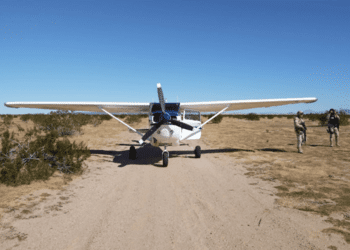Mexican authorities have intercepted a succession of flights carrying synthetic drugs to the northern state of Sonora, with the state acquiring greater importance as a smuggling corridor to the United States.
On April 8, the Mexican Army and Air Force forced an unknown aircraft to divert course and seized the over 370 kilograms of drugs it hurriedly dropped off, including 276 kilograms of methamphetamine and 49 kilograms of fentanyl, according to a Defense Ministry press release.
Months earlier, on January 24, authorities made a remarkably similar interdiction when a plane from Sinaloa’s state capital of Culiacán was chased down. Upon its landing in the Sonoran municipality of Puerto Peñasco, authorities found 39 kilograms of methamphetamine and 65 kilograms of fentanyl, among other drugs.
SEE ALSO: Synthetic Drugs Flood California Crossing of US-Mexico Border
About a week before that, on January 15, another clandestine aircraft was harried into touching down at Puerto Peñasco. It was transporting 433 kilograms of methamphetamine and 29 kilograms of fentanyl. Significant plane seizures of synthetic drugs also occurred throughout 2021 in Sonora.
However, aerial trafficking has not entirely displaced other smuggling methodologies in Sonora. In March, Mexican authorities seized a yet-to-be-transported drug shipment allegedly belonging to the Sinaloa Cartel, securing nearly 1.9 metric tons of methamphetamine and 57 kilograms of fentanyl.
InSight Crime Analysis
Sonora’s role in the synthetic drug trade is defined by its geography: on the west, it receives Asian chemical precursors from its port of Guaymas, on the south, it abuts Mexico’s primary synthetic drug producer of Sinaloa, and on the north, it borders the US state of Arizona.
As such, “Sonora has always been a key port of entry,” said Cecilia Farfán-Méndez, an organized crime expert and the head of Security Research Programs at the Center for US-Mexican Studies at the University of California, San Diego.
“[Nowadays], private small aircraft have increasingly become an area of concern for the movement of drugs [north],” she told InSight Crime.
SEE ALSO: The Three Criminal Fronts Sparking Violence in Sonora, Mexico
Interestingly, in recent years it has been Sonora’s neighbor of Baja California that has emerged as the Mexican synthetic drug superhighway. Methamphetamine and fentanyl interdicted at US border crossings have been overwhelmingly concentrated between and at Californian ports of entry, according to US Customs and Border Patrol (CBP) seizure data.
Yet Sonora’s share of the traffic appears to be increasing. In 2019, Mexican media were already reporting on the growing presence of synthetic drug flows. Since then, CBP data shows a noticeable increase in fentanyl seizures on the US border with Sonora – more so than other border states.
The recent spate of drug flights point to the same conclusion, particularly given the Defense Ministry has only reported one similar seizure in Baja California since January 2021 despite the Ministry’s radars theoretically covering both state’s airspaces equally.
One confounding factor that may mask Sonora’s level of increased importance is also that synthetic drug loads in Sonora are at times trafficked to Baja California for onward smuggling into the United States, according to Mexican authorities, but rarely the other way around. In these cases, border seizure data listing a Californian interdiction does not register its Sonoran transit, thus artificially downplaying the latter’s share of the traffic.

